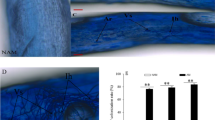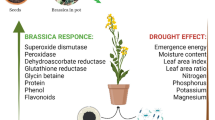Abstract
Nitrogen contents were determined in 20 species of “resurrection plants”,i.e. plants with leaves which are able to revive from an air-dry state (viz. Boea hygroscopica, Borya nitida, Cheilanthes sieberi, Coleochloa pallidior, C. setifera, Craterostigma plantagineum, Myrothamnus flabellifolia, Oropetium capense, Pellaea calomelanos, P. falcata, P, viridis, Polypodium polypodioides, Ramondia pyrenaica, Selaginella lepidophylla, Sporobolus stapfianus, Talbotia elegans,Tripogon loliiformis, Xerophyta retinervis, X. villosa, X. viscosa), and in three desiccation sensitive species (Eragrostis tenuifolia, Selaginella kraussiana andSporobolus pyramidalis).
In a preponderance of resurrection plants insoluble nitrogen content fell during dehydration of intact plants and soluble non-protein N rose. Both changes were particularly marked in species which lose chlorophyll and thylakoid structure during drying. These trends were usually only partially reversed after 24 h rehydration. Recovery of14C-leucine incorporation in rehydrating leaves was slow.
Leaves of desiccation sensitive vascular plants tended on the average to lose soluble protein rather than insoluble N during drying, and tended to have higher soluble non-protein N contents than tolerant plants.
However, similarity in the changes in N-contents inXerophyta villosa leaves killed by airdrying compared to leaves surviving air-drying, opposes the view that death was due to excessive loss of protein.
Similar content being viewed by others
Abbreviations
- EM:
-
electron microscope
- NCS:
-
NCS tissue solubilizer, Amersham/Searle, Illinois
- POPOP:
-
l,4-bis-2(4-methyl-5-phenyl)oxazolylbenzene
- PPO:
-
2,5-diphenyloxazole
- 1 μCi:
-
37 kBq
References
Barnett, N. M., Naylor, A. W.: Amino acid and protein metabolism in Bermuda grass during water stress. - Plant Physiol.41: 1222–1230, 1966.
Bewley, J. D.: Polyribosomes conserved during desiccation of the mossTortula ruralis are active. - Plant Physiol.51: 285–288, 1973a.
Bewley, J. D.: Desiccation and protein synthesis in the mossTortula ruralis. - Can. J. Bot.51: 203–206, 1973b.
Gaff, D. F.: The desiccation tolerant higher plants of Southern Africa. - Science174: 1033 to 1034, 1971.
Gaff, D. F.: Desiccation tolerant vascular plants of Southern Africa. - Oecologia31: 95–109, 1077.
Gaff, D. F., Ellis, R. P.: Southern African grasses with foliage that revives after dehydration. - Bothalia11: 305–308, 1974.
Gaff, D. F., Latz, P. K.: Australian resurrection plants, including some grasses. - Aust. J. Bot. (in press) 1978.
Gaff, D. F., Zee, S.-Y., O’Brien, T. P.: The fine structure of dehydrated and reviving leaves ofBorya nitida Labill. - a desicaation-tolerant plant. - Aust. J. Bot.24: 226–236, 1976.
Gessner, F.: Die Wasseraufnahme durch Blätter und Samen. - In:Ruhland, W. (ed.): Handbuch der Pflanzenphysiologie. Vol. 3. Pp. 215–246. Springer-Verlag, Berlin 1956.
Hallam, N., Gaff, D. F.: Re-organization of fine structure during rehydration of desiccated leaves ofXerophyta villosa. - New Phytol.81: 349–355, 1978.
Hallam, N. D., Gaff, D. F.: Regeneration of chloroplast structure inTalbotia elegans, a desiccation tolerant plant. - New Phytol. (in press) 1979.
Levitt, J.: Responses of Plants to Environmental Stresses. - Academic Press, New York-London 1972.
Maranville, J. W., Paulsen, G. M.: Alteration of protein composition of corn (Zea mays L.) seedlings during water stress. - Crop Sci.12: 660–663, 1972.
Shah, C. B., Loomis, R. S.: Ribonucleic acid and protein metabolism in sugar beet during drought. - Physiol. Plant.18: 240–254, 1965.
Umbreit, W., Burris, R. H., Stauffer, J. F.: Manometric Techniques 2nd Ed. - Burgess Publ. Co., Minneapolis 1959.
Vieweg, G. H., Ziegler, H.: Zur Physiologie vonMyrothamnus flabellifolia. - Ber. deut. bot. Ges.82: 29–36, 1969.
Wellburn, F. A. M., Wellburn, A. R.: Novel chloroplasts and unusual cellular ultrastructure in the ‘resurrection plant’Myrothamnus flabellifolia Welw. (Myrothamnaceae). - Bot. J. Linn. Soc..72: 51–54, 1976.
Zucker, M., Stinson, H. T.: Chloroplasts as the major protein-bearing structures inOenothera leaves. -Arch. Biochem. Biophys.96: 637–644, 1962.
Author information
Authors and Affiliations
Rights and permissions
About this article
Cite this article
Gaff, D.F., McGregor, G.R. The effect of dehydration and rehydration on the nitrogen content of various fractions from resurrection plants. Biol Plant 21, 92–99 (1979). https://doi.org/10.1007/BF02909453
Received:
Accepted:
Published:
Issue Date:
DOI: https://doi.org/10.1007/BF02909453




